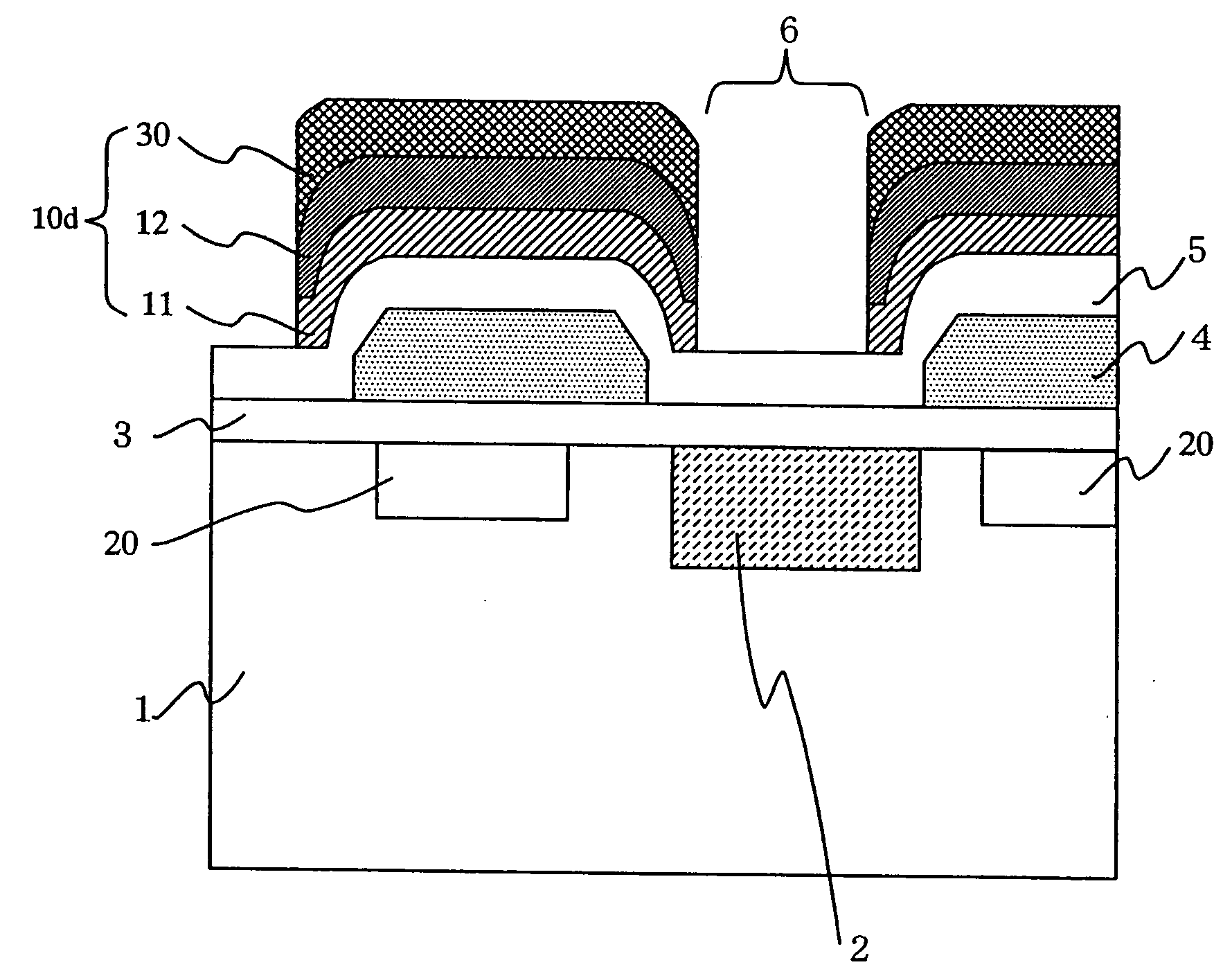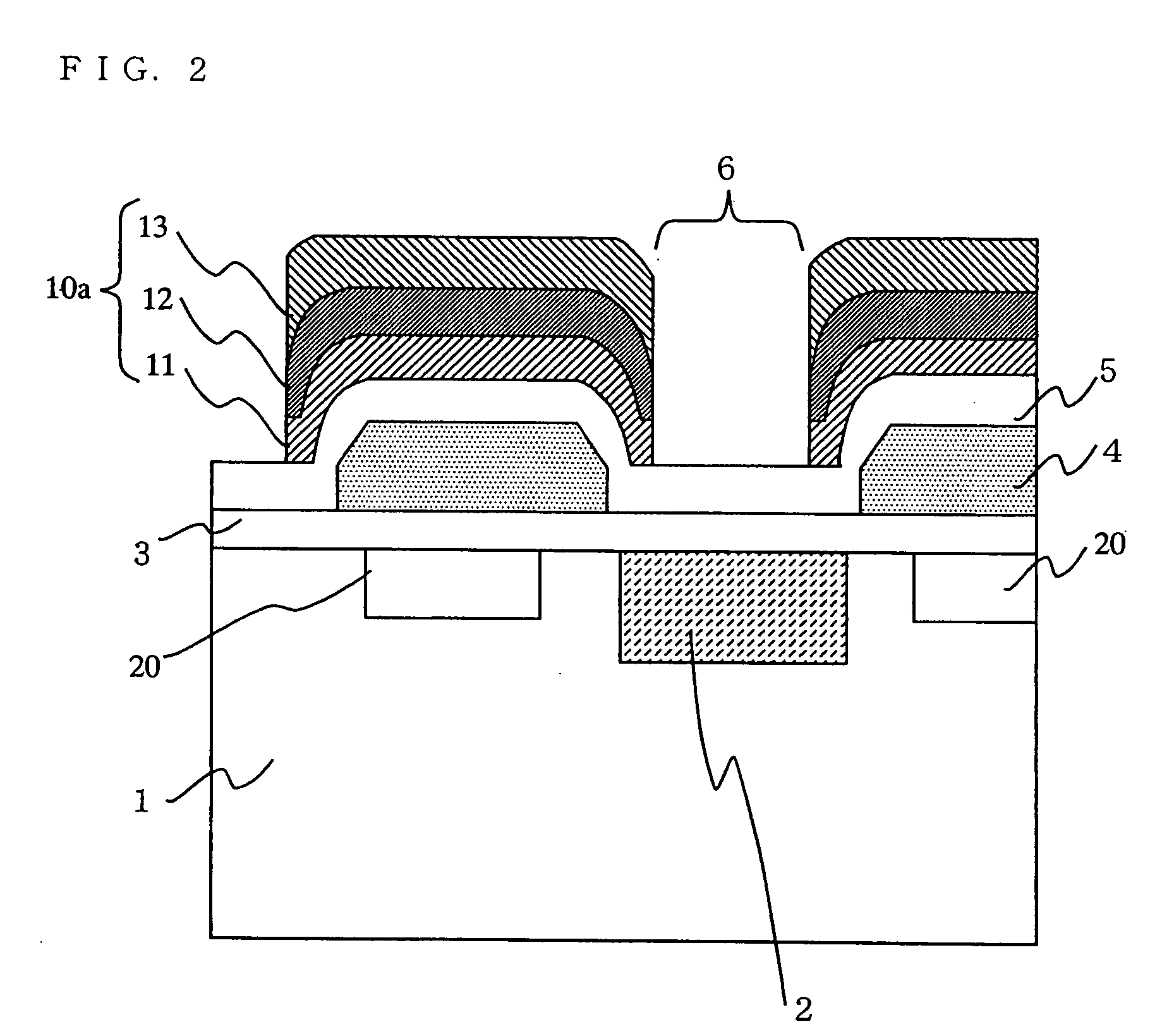Solid-state imaging device and method for producing the same
a solid-state imaging and imager technology, applied in the direction of semiconductor devices, radio frequency controlled devices, electrical devices, etc., can solve the problems of large problem of resist pattern peeling at the time, shielding film b>10/b>i>e /i>, etc., to reduce the size of pixels, small pattern size, good yield
- Summary
- Abstract
- Description
- Claims
- Application Information
AI Technical Summary
Benefits of technology
Problems solved by technology
Method used
Image
Examples
first embodiment
[0032]FIG. 1 shows an example of a cross-sectional structure of a commonly used solid-state imaging device. In a solid-state imaging device 100 shown in FIG. 1, a semiconductor substrate 1 is an epitaxial high-resistivity substrate in which an epitaxial layer 1b is formed on a main surface of a silicon substrate la by epitaxially growing a single crystal silicon layer. Photodiodes 2 of a conductivity type opposite to that of the epitaxial layer 1b are formed in a main surface of the semiconductor substrate 1 and generate charges in accordance with the intensity of received light. Charge transfer portions 20 are formed in the main surface of the semiconductor substrate 1 and transport charges that are generated in the photodiodes 2. Gate electrodes 4 are provided adjacent to each photodiode 2 on the semiconductor substrate 1 and serve as switches for moving the charges generated in the photodiodes 2 to the charge transfer portions 20. A light-shielding film 10a is formed so as to cov...
second embodiment
[0054]In this embodiment, a solid-state imaging device having a light-shielding film whose surface is formed of a high melting point metal silicide film, instead of the light-shielding film 10a whose surface is formed of the amorphous silicon film 13 of the first embodiment will be described. The solid-state imaging device of this embodiment has substantially the same structure as the solid-state imaging device 100 of the first embodiment, so that in the following, only different points will be described.
[0055]FIG. 6 shows a cross-sectional structure of a solid-state imaging device of the second embodiment of the present invention. In FIG. 6, the light-shielding film 10b is a film having a two-layered structure in which a tungsten-sputtered film 11, which is a high melting point metal film, and a tungsten silicide film 14, which is a high melting point metal silicide film, are laminated. The tungsten-sputtered film 11 serves as an adhesive layer for the tungsten silicide film 14. Th...
third embodiment
[0061]In this embodiment, a solid-state imaging device having a light-shielding film whose surface is formed of a high melting point metal silicide film having a three-layered structure, instead of the light-shielding film 10b having a two-layered structure of the second embodiment will be described. The second embodiment is different from the third embodiment in the number of films constituting the light-shielding film, and therefore in the following, only different points will be described.
[0062]FIG. 7 shows a cross-sectional structure of a solid-state imaging device of the third embodiment of the present invention. In FIG. 7, the light-shielding film 10c is a film having a three-layered structure in which a tungsten-sputtered film 11, and a tungsten CVD film 12, which are high melting point metal films, and a tungsten silicide film 14, which is a high melting point metal silicide film, are laminated. The tungsten-sputtered film 11 serves as an adhesive layer for the tungsten CVD ...
PUM
| Property | Measurement | Unit |
|---|---|---|
| thickness | aaaaa | aaaaa |
| thickness | aaaaa | aaaaa |
| temperature | aaaaa | aaaaa |
Abstract
Description
Claims
Application Information
 Login to View More
Login to View More - R&D
- Intellectual Property
- Life Sciences
- Materials
- Tech Scout
- Unparalleled Data Quality
- Higher Quality Content
- 60% Fewer Hallucinations
Browse by: Latest US Patents, China's latest patents, Technical Efficacy Thesaurus, Application Domain, Technology Topic, Popular Technical Reports.
© 2025 PatSnap. All rights reserved.Legal|Privacy policy|Modern Slavery Act Transparency Statement|Sitemap|About US| Contact US: help@patsnap.com



